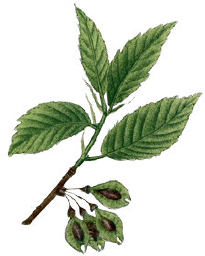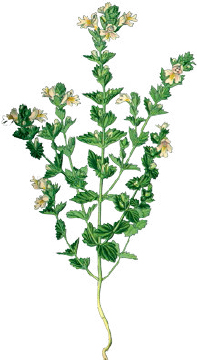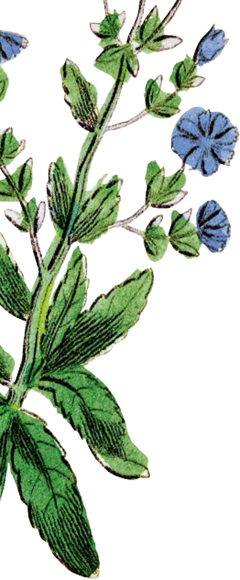E
ELDER
(SAMBUCUS NIGRA)
The Elder Tree

I hold it needless to write any description of this, since every boy that plays with a pop-gun will not mistake another tree instead of Elder.
PLACE: The Elder-tree grows in hedges, being planted there to strengthen the fences and partitions of ground, and to hold the banks by ditches and water-courses. [Found throughout Europe, central Asia, North Africa, and naturalized in eastern South America. The North American Sambucus canadensis is also called Sambucus nigra subsp. canadensis.]
Government and virtues: [Elder is] under the dominion of Venus. The first shoots of the common Elder boiled like Asparagus, and the young leaves and stalks boiled in fat broth, doth mightily carry forth phlegm and choler [bile]. The middle or inward bark boiled in water, and given in drink, works much more violently; and the berries, either green or dry, expel the same humour, and are often given with good success to help the dropsy; the bark of the root boiled in wine, or the juice thereof drank, works the same effects, but more powerfully than either the leaves or fruit. The juice of the root taken, doth mightily procure vomiting, and purges the watery humours of the dropsy. The decoction of the root taken, cures the biting of an adder. It mollifies the hardness of the mother, if women sit thereon, and opens their veins, and brings down their courses: The berries boiled in wine perform the same effect; and the hair of the head washed therewith is made black. The juice of the green leaves applied to the hot inflammations of the eyes, assuages them. The decoction of the berries in wine, being drank, provokes urine; the distilled water of the flowers is of much use to clean the skin from sun-burning, freckles, morphew [blemishes], or the like; and takes away the headache, coming of a cold cause, the head being bathed therewith. The leaves or flowers distilled in the month of May, and the legs often washed with the said distilled water, it takes away the ulcers and sores of them. The eyes washed therewith, it takes away the redness and bloodshot; and the hands washed morning and evening therewith, helps the palsy, and shaking of them.
MODERN USES: Elder has been rehabilitated in modern phytomedicine. Taken in the form of extracts of the dried ripe elderberry fruit, it is one of the most widely used medicinal plants for the prevention and treatment of viral infections, particularly upper respiratory tract infections associated with colds and flu. Antiviral, antioxidant, and immunomodulatory activity are ascribed to the fruits. The dried fruits also have laxative effects. The dried flowers are traditionally used to treat colds, fever, and upper respiratory tract congestion. CAUTION: Avoid ingesting unripe berries or fresh plant parts as they contain cyanogenic glycosides that can cause symptoms of cyanide toxicity. Allergic reactions to elder are reported.
ELDER, DWARF
(SAMBUCUS EBULUS)
Danewort

DESCRIPTION: This is but an herb every year, dying with his stalks to the ground, and rising afresh every Spring, and is like unto the Elder both in form and quality, rising up with square, rough, hairy stalks, four feet high, or more sometimes.
PLACE: [The Dwarf Elder grows wild in many places in Europe and North Africa.]
GOVERNMENT AND VIRTUES: Both Elder and Dwarf Tree are under the dominion of Venus.
The Dwarf Elder is more powerful than the common Elder in opening and purging choler [bile], phlegm, and water; in helping the gout, piles, and women’s diseases, colours the hair black, helps the inflammations of the eyes, and pains in the ears, the biting of serpents, or mad dogs, burnings and scalding, the wind cholic, cholic, and stone, the difficulty of urine, the cure of old sores and fistulous ulcers. Either leaves or bark of Elder, stripped upwards as you gather it, causes vomiting.
MODERN USES: Dwarf elder is used far less than common elder. The dried flowers and dried fruits have a long history in traditional medicines, especially in southern Europe and central Asia. Preparations have been used in the treatment of inflammatory reactions from insect bites, sore throat, and hemorrhoids, among other uses. Components in the plant have been shown experimentally to have anti-inflammatory, antioxidant, and pain-relieving activity. A gel containing dwarf elder extract for the treatment of knee osteoarthritis showed positive results in a clinical study. CAUTION: Avoid ingesting unripe berries or fresh plant parts as they contain cyanogenic glycosides that can cause symptoms of cyanide toxicity. Allergic reactions to elder are reported.
ELECAMPANE
(INULA HELENIUM)

DESCRIPTION: It shoots forth many large leaves, long and broad, of a whitish green on the upper side, which arise up three or four feet high, bearing diverse great and large [yellow] flowers. The root is great and thick, of a very bitter taste, and strong, but good scent.
PLACE: It grows on moist grounds, and shady places and open borders of the fields, and in other waste places. [Native to most of temperate Asia and western Europe; escaped from gardens and found throughout Europe and much of eastern North America].
GOVERNMENT AND VIRTUES: It is a plant under the dominion of Mercury. The fresh roots of Elecampane preserved with sugar, or made into a syrup or conserve, are very effectual to warm a cold windy stomach, or the pricking therein, and sti[t]ches in the sides caused by the spleen; and to help the cough, shortness of breath, and wheezing in the lungs. The dried root made into powder, and mixed with sugar, and taken, serves to the same purpose, and is also profitable for those who have their urine stopped, or the stopping of women’s courses, the pains of the mother and the stone in the kidneys, or bladder; it resists poison, and stays the spreading of the venom of serpents, as also putrid and pestilential fevers, and the plague itself. The roots and herbs beaten and put into new ale or beer, and daily drank, clears, strengthens, and quickens the sight of the eyes wonderfully. The decoction of the roots in wine, or the juice taken therein, kills and drives forth all manner of worms in the belly, stomach, and maw; and gargled in the mouth, or the root chewed, fastens loose teeth, and helps to keep them from putrefaction. And being drank is good for those that spit blood, helps to remove cramps or convulsions, gout, sciatica, pains in the joints, applied outwardly or inwardly, and is also good for those that [have hernias], or have any inward bruise. The root boiled well in vinegar beaten afterwards, and made into an ointment with hog’s suet, or oil of trotters is an excellent remedy for scabs or itch in young or old; the places also bathed or washed with the decoction doth the same; it also helps all sorts of filthy old putrid sores or cankers whatsoever. The distilled water of the leaves and roots together, is very profitable to cleanse the skin of the face, or other parts, from any morphew [skin blemishes], spots, or blemishes therein, and make it clear.
MODERN USES: Elecampane root has been used for upper respiratory tract catarrhs, as an expectorant and cough suppressant in cases of bronchitis, dry cough, and pertussis. Traditionally, it has also been used for gastrointestinal tract conditions, as a worm expellant, and for the treatment of kidney and lower urinary tract infections. It has confirmed antimicrobial and antioxidant activity. CAUTION: The root contains a class of chemical components called sesquiterpene lactones, which are known to be irritating to the mucous membranes and may cause allergic reactions by binding to skin proteins and inducing hypersensitivity. Massage oil containing the root has produced allergic skin reactions.
ELM
(ULMUS SPP.)

This tree is so well known, growing generally in all counties of this land, that it is needless to describe it.
PLACE: [Trees and shrubs in the genus Ulmus, elms are represented by twenty-five to thirty species found in temperate regions of the Northern Hemisphere. They tend to be common woodland species in Europe, temperate Asia, and North America. Elms can be challenging to identify as hybrids take on features of both parents.]
GOVERNMENT AND VIRTUES: It is a cold and saturnine plant. The leaves thereof bruised and applied, heal green wounds, being bound thereon with its own bark. The leaves or the bark used with vinegar, cures scurf and leprosy very effectually. The decoction of the leaves, bark, or root, being bathed, heals broken bones. The water that is found in the bladders on the leaves, while it is fresh, is very effectual to cleanse the skin, and make it fair; and if cloth be often wet therein, and applied to the ruptures of children, it heals them, if they be well bound-up with a truss. The decoction of the bark of the root, fomented, mollifies hard tumours, and the shrinking of the sinews. The roots of the Elm, boiled for a long time in water, and the fat arising on the top thereof, being clean skimmed off, and the place anointed therewith that is grown bald, and the hair fallen away, will quickly restore them again. The said bark ground with brine or pickle, until it come to the form of a poultice, and laid on the place pained with the gout, gives great ease. The decoction of the bark in water, is excellent to bathe such places as have been burnt with fire.
MODERN USES: Culpeper only treats elms in the generic sense, and it is not clear which species or hybrids he refers to. It is likely that in Culpeper’s day, all elms were treated as a single entity. The North American species known as slippery elm (Ulmus rubra; syn. Ulmus fulva) is unique among elms in having high amounts of mucilage in the inner bark; therefore, it is used for the treatment of mucous membrane inflammations such as sore throat and is approved as a nonprescription drug (in lozenge form) in the United States.
ENDIVE
(CICHORIUM ENDIVA)

DESCRIPTION: Common garden Endive bears a longer and larger leaf than Succory [Chicory], and abides but one year; it has blue flowers.
PLACE: [Endive is essentially a garden plant of uncertain geographical origin, probably from southern Europe. Genetic selections likely evolved from wild chicory (Cichorium intybus). Endive differs from chicory in that it is an annual and less bitter in taste. It is an occasional waif at a garden’s edge, a relic from cultivation.]
GOVERNMENT AND VIRTUES: It is a fine cooling, cleansing, jovial plant. The decoction of the leaves, or the juice, or the distilled water of Endive, serve well to cool the excessive heat of the liver and stomach, and in the hot fits of agues, and all other inflammations in any part of the body; it cools the heat and sharpness of the urine, and excoriation in the urinary parts. The seeds are of the same property, or rather more powerful, and besides are available for fainting, swoonings, and passions of the heart. Outwardly applied, they serve to temper the sharp humours of fretting ulcers, hot tumours, swellings, and pestilential sores; and wonderfully help not only the redness and inflammations of the eyes, but the dimness of the sight also; they are also used to allay the pains of the gout. You cannot use it amiss; a syrup of it is a fine cooling medicine for fevers.
MODERN USES: Endive leaves are a nutritious vegetable, but have no other use in modern herbal medicine. See chicory (page 55) for medicinal information.
ERYNGO
(ERYNGIUM MARITIMUM)
Eringo, or Sea-Holly

DESCRIPTION: The first leaves of our ordinary Sea-holly, are nothing so hard and prickly as when they grow old, being almost round, and deeply dented about the edges, hard and sharp pointed, and a little crumpled, of a bluish green colour. The root grows wonderfully long, even to eight or ten feet; of a pleasant taste, but much more, being artificially preserved, and candied with sugar.
PLACE: It is found about the sea coast in almost every [country of Europe and North Africa] which borders upon the sea.
GOVERNMENT AND VIRTUES: The plant is venereal, and breeds seed exceedingly, and strengthens the spirit procreative; it is hot and moist, and under the celestial Balance. The decoction of the root hereof in wine, is very effectual to open obstructions of the spleen and liver, and helps yellow jaundice, dropsy, pains of the loins, and wind cholic, provokes urine, and expels the stone, procures women’s courses. The continued use of the decoction for fifteen days, taken fasting, and next to bedward, doth help the strangury, the difficulty and stoppage of urine, and the stone, as well as all defects of the lower back and kidneys; and if the said drink be continued longer, it is said that it cures the stone; it is found good against the French pox [syphilis]. The roots bruised and applied outwardly, help the kernels of the throat, commonly called the king’s evil; or taking inwardly, and applied to the place stung or bitten by any serpent, heal it speedily. If the roots be bruised, and boiled in old hog’s grease, or salted lard, and broken bones, thorns &c. remaining in the flesh, they do not only draw them forth, but heal up the place again, gathering new flesh where it was consumed. The distilled water of the whole herb, when the leaves and stalks are young, is profitable drank for all the purposes aforesaid; and helps the melancholy of the heart, as also for them that have their necks drawn awry, and cannot turn them without turning their whole body.
MODERN USES: In folk medicine in various traditions, especially in regions along the western Mediterranean coast, eryngo root is used for its anti-inflammatory and pain-relieving qualities in the treatment of inflammatory conditions of the urinary tract, such as urethritis, cystitis, and blockage or irritation of the bladder. It is also used as a cough suppressant. The essential oil of the seeds has antioxidant and antimicrobial activity. CAUTION: Some Eryngium species are known to cause gastrointestinal irritation.
EYEBRIGHT
(EUPHRASIA OFFICINALIS AND RELATED SPECIES)

DESCRIPTION: Common Eyebright is a small, low herb. At the joints with the leaves, come forth small white flowers, marked with purple and yellow spots, or stripes.
PLACE: It grows in meadows, and grassy land. [Eyebright is a taxonomically complex plant group with over 350 microspecies collectively treated by herbalists as Euphrasia officinalis. It is found throughout cooler regions of the Northern Hemisphere.]
GOVERNMENT AND VIRTUES: It is under the sign of the Lion, and Sol claims dominion over it. If the herb was but as much used as it is neglected, it would half spoil the spectacle maker’s trade; and a man would think, that reason should teach people to prefer the preservation of their natural before artificial spectacles; which that they may be instructed how to do, take the virtues of Eyebright as follows.
The juice or distilled water of Eyebright, taken inwardly in white wine or broth, or dropped into the eyes for diverse days together, helps all infirmities of the eyes that cause dimness of sight. Some make conserve of the flowers to the same effect. Being used any of the ways, it also helps a weak brain, or memory.
MODERN USES: Since before Culpeper’s time, eyebright has been applied to the eyes either as a poultice or wash to treat conjunctivitis, eye fatigue, itchy irritated eyes, and other eye conditions. It has confirmed astringent and anti-inflammatory activity and possible protective effects against corneal-damaging ultraviolet B rays. CAUTION: Use only under the care and direct advice of a qualified medical practitioner.

